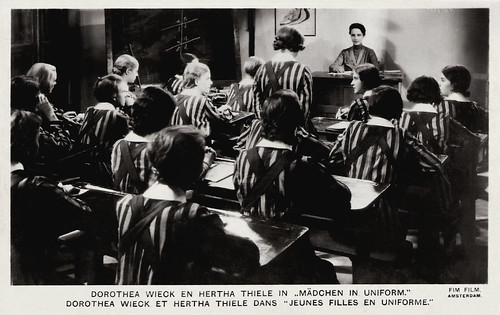
Dutch Postcard by M. Bonnist & Zonen, Amsterdam, Z., no. 104 e. Photo: Fim Film, Amsterdam. Publicity still for Mädchen in Uniform/Girls in Uniform (Leontine Sagan, Carl Froelich, 1931).
Spirited and independent
Manuela von Meinhardis (Hertha Thiele), a spirited and independent 14-year old schoolgirl, is sent to a boarding school for daughters of officers in Northern Germany, when her mother dies. The girls at this Catholic boarding school are slight, pale creatures - hungry for food and comfort.
The authoritarian head mistress, Fraülein von Nordeck zur Nidden (Emilia Unda), runs the school with an iron hand. She believes that daughters of Prussian soldiers must be taught discipline and deprivation, not luxury.
Ilse (Ellen Schwannecke) is the school trouble-maker, leader, and clown. Witty and outspoken, she repeatedly entertains the other girls, binding them together in secret comradery against their oppressive elders.
Like the rest of the girls, Manuela yearns for the attention of the fair and beautiful Elizabeth Von Bernburg (Dorothea Wieck), a young teacher who believes it's important to be the children's trusted friend. Manuela is ecstatic when Fraülein von Bernburg presents her with a gift, one of her slips, to replace the girl's own tattered underwear.
Relief from the regimentation of school life comes when the girls stage a theatrical production for students, staff and trustees of the boarding school. Manuela's performance as Don Carlos is accomplished and praised by students and staff.
At a party following the play, Manuela is the only student who can tolerate the taste of the punch given to them as a reward. Her friends pass their cups on to her and she soon gets herself quite drunk. In a semi-conscious state she announces her feelings for Fraulein von Burnberg to the entire school along with the infuriated Headmistress.
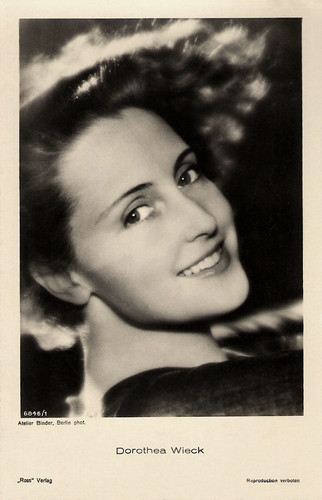
Dorothea Wieck. German postcard by Ross Verlag, no. 6846/1, 1931-1932. Photo: Atelier Binder, Berlin.

Hertha Thiele. German postcard by Ross Verlag, no. 6997/1, 1931-1932. Photo: Ufa.
At speed and on a low budget
German actress Hertha Thiele began her professional acting career in 1928 as a stage actress in Leipzig.
There she had her breakthrough two years later with the play Ritter Nérestan (Knight Nérestan) by Christa Winsloe.
Thiele and Claire Harden played the lead roles in this tale set in a Prussian boarding school for girls. The play, directed by Leontine Sagan, was an immediate success at its premiere in 1930.
After Leipzig the play was produced on stage in Berlin as Gestern und heute (Yesterday and Today), with a different cast and a more prominent lesbian theme. Again it was a huge success.
This success prompted Carl Froelich to adapt it for film. Reportedly he toned the lesbian theme somewhat down. He invited Leontine Sagan, for whom it was her first film. to join. The direction was split into direction of the cast and mise-en-scene by Sagan and overall direction by Carl Froelich, the Künstleriche Oberleitung.
After many screen tests, author Christa Winsloe insisted that Hertha Thiele played the lead role. Director Sagan preferred Gina Falckenberg who had done the role on stage in Berlin.
Thiele had already played a young lesbian in Ferdinand Bruckner's stage play Die Kreatur (The Creature) and although twenty-three years old when filming began, she was considered to be more capable of portraying a fourteen-year-old. The role of the adored teacher Fräulein von Bernburg was given to Swiss actress Dorothea Wieck.
Having mostly played the same roles on stage, the all-female cast was able to produce the film at speed and on a low budget of RM55,000. It was largely shot at the Potsdam military orphanage, now a teacher training college for women. Carl Froelich's studio in Berlin-Tempelhof was also used.

British card in the series Film Shots by Film Weekly. Photo: Deutsche. Publicity still for Mädchen in Uniform/Girls in Uniform (Leontine Sagan, Carl Froelich, 1931) with Ellen Schwannecke and Dorothea Wieck.
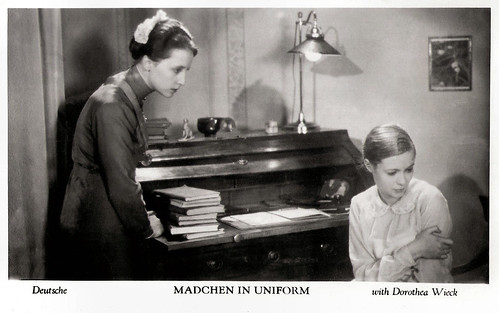
British card in the series Film Shots by Film Weekly. Photo: Deutsche. Publicity still for Mädchen in Uniform/Girls in Uniform (Leontine Sagan, Carl Froelich, 1931) with Dorothea Wieck and Hertha Thiele.
Goodnight kiss
From its premiere at the Capitol cinema in Berlin until 1934 Mädchen in Uniform grossed some RM 6,000,000. It was a success throughout much of Europe. The film won the audience referendum for Best Technical Perfection at the Venice Film Festival in 1932 and received the Japanese Kinema Junpo Award for Best Foreign Language Film in 1934.
The international success made of both Wieck and Thiele major stars. The goodnight kiss Thiele received from Wieck was especially popular: one distributor even asked for more footage of other kisses like it to splice into prints of the film.
Mädchen in Uniform was ground-breaking as one of the earliest narrative films to explicitly portray homosexuality. The two stars received thousands of fan letters, mostly from women, and both became lesbian idols. This made the film also very controversial.
Author Christa Winsloe was a lesbian. She was educated in the Empress Augusta boarding school, where Mädchen in Uniform was set. Reportedly there really was a Manuela, who remained lame all of her life after she threw herself down the stairs. She came to the premiere of the film and for Winsloe this experience was one she had to write from her heart.
Jan Onderwater at IMDb: "The play as well as the later novel emphasizes the sexual/lesbian love theme, but the film adaptation was toned down; the original sad end was replaced by a happy end. Though the film goes as far as it can in its theme of (awakening) lesbian feelings and sexual feelings of young girls in general, shifting emphasis automatically meant concentrating on the theme of the cold and inhumane authoritarian (Prussian) way of life and upbringing, a way of thinking still present in the Weimar republic and in 1931 already considered a danger to the young republic. Then audiences were more interested in this aspect than in the sexual one."
In the US, the film was first banned, but First Lady Eleanor Roosevelt saw the importance of it and the film got a limited American release in 1932-1933.
In Germany, an alternate ending which subtly pandered to pro-Nazi ideals enabled continued screening in German cinemas, but eventually even this version of the film was banned as 'decadent' by the Nazi regime, which reportedly attempted to burn all of the existing prints.
Leontine Sagan and many others associated with the film fled Germany soon after the banning. Many of the cast and crew were Jewish, including Emilia Unda and Ellen Schwannecke, and those who could not escape from Germany died in the camps. When assistant director Walter Supper realized his Jewish wife would be arrested, he shot her, himself and his dog.
Despite its later banning, Mädchen in Uniform was followed by several German films about intimate relationships among women, such as Acht Mädels im Boot/Eight Girls in a Boat (1932), Ich für dich, du für mich/Me for you, you for me (Carl Froelich, 1934) and Anna und Elisabeth/Anna and Elisabeth (Leontine Sagan, 1933), which also starred Wieck and Thiele but was banned by the Nazis soon after its opening night.
After the war, Mädchen in Uniform is said to have inspired the 1949 novel Olivia by Dorothy Bussy, which treats very similar themes, and which was made into the French film Olivia (Jacqueline Audry, 1951). And there was a German remake, Mädchen in Uniform, (Géza von Radványi, 1958) starring Lilli Palmer, Romy Schneider, and Therese Giehse.
The Nazis had attempted to burn all of the existing prints, but several had been dispersed around the world and survived the war. The screened film versions were heavily censored until the 1970s, and it was not shown again in Germany until 1977 when it was screened on television there. A year later, the film was re-released in the US. It's now an international cult classic, but according to Wikipedia even this and later released versions probably miss some brief scenes.

British card in the series Film Shots by Film Weekly. Photo: Deutsche. Publicity still for Mädchen in Uniform/Girls in Uniform (Leontine Sagan, Carl Froelich, 1931) with Dorothea Wieck and Emilia Unda.
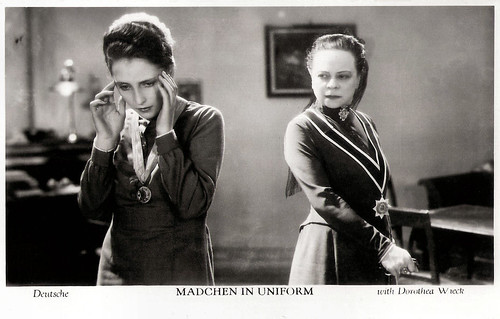
British card in the series Film Shots by Film Weekly. Photo: Deutsche. Publicity still for Mädchen in Uniform/Girls in Uniform (Leontine Sagan, Carl Froelich, 1931) with Dorothea Wieck and Emilia Unda.
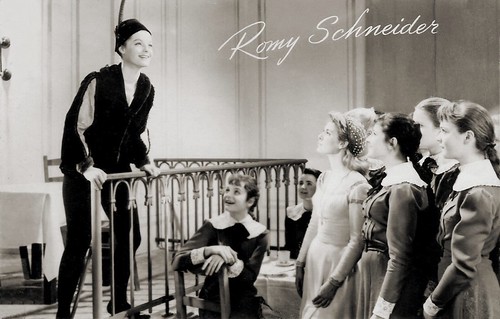
Dutch postcard by Takken, Utrecht (printed by 't Sticht), no. AX 3879, posted by mail in 1959. Photo: Grimm / C.C.C. / Gloria. Publicity still for Mädchen in Uniform/Girls in Uniform (Géza von Radványi, 1958) with Romy Schneider.
Sources: Heide Schlüpmann & Karola Gramman (Screening the past), Jan Onderwater (IMDb), Wikipedia and IMDb.
No comments:
Post a Comment